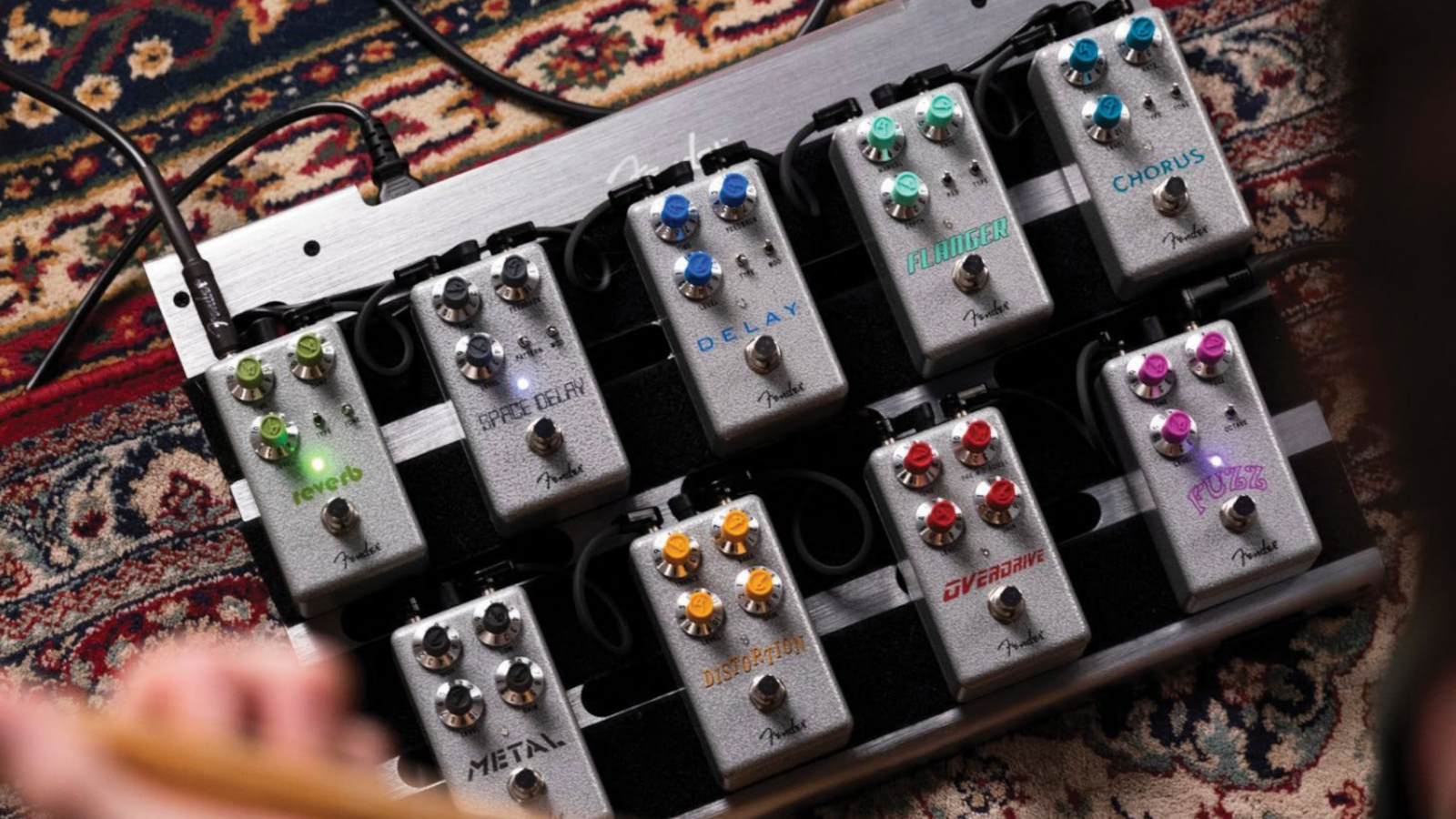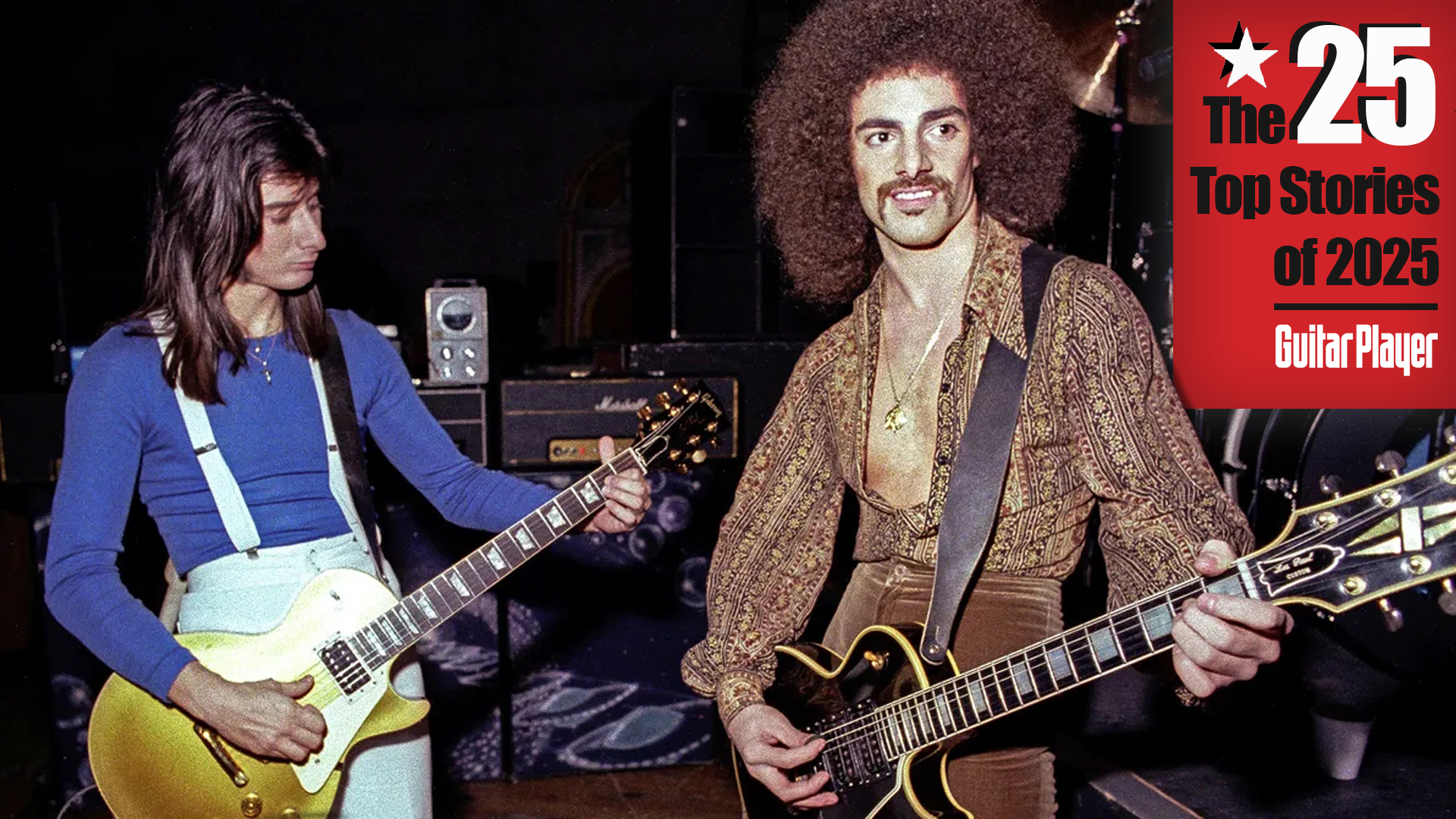GuitarPlayer Verdict
These back-to-basics tone machines are characterful, versatile and affordable
Pros
- +
See below
Cons
- -
See below
You can trust Guitar Player.
Fender’s new line of Hammertone effects pedals features nine models, all in the same grey-finished 4.375 x 2.375 x 1.375-inch aluminum enclosure, with differently colored “F” logo “witch-hat” knobs derived from Fender’s semi-hollow Starcaster guitar of the mid to late ’70s.
Priced at what’s arguably the entry level for roadworthy pedals, the full range includes the utilitarian-monikered Overdrive, Distortion, Fuzz, Metal, Reverb, Delay, Space Delay, Flanger and Chorus.
The drive-based pedals are fully analog, while the others use digital processing with analog dry-through
There are no compressor, phaser or tremolo models yet, although rumors of future additions abound.
The drive-based pedals are fully analog, while the others use digital processing with analog dry-through.
Other commonalities of the range include true-bypass switching and top-mounted mono input and output jacks either side of the center-negative nine-volt jack (a nine-volt battery can also be used internally).
All were tested using a Fender Telecaster with standard single-coil pickups and a Gibson Les Paul with full-size humbuckers into a Friedman Dirty Shirley Mini and 2x12 cab, and a Fender Princeton Reverb Reissue combo.
OVERDRIVE
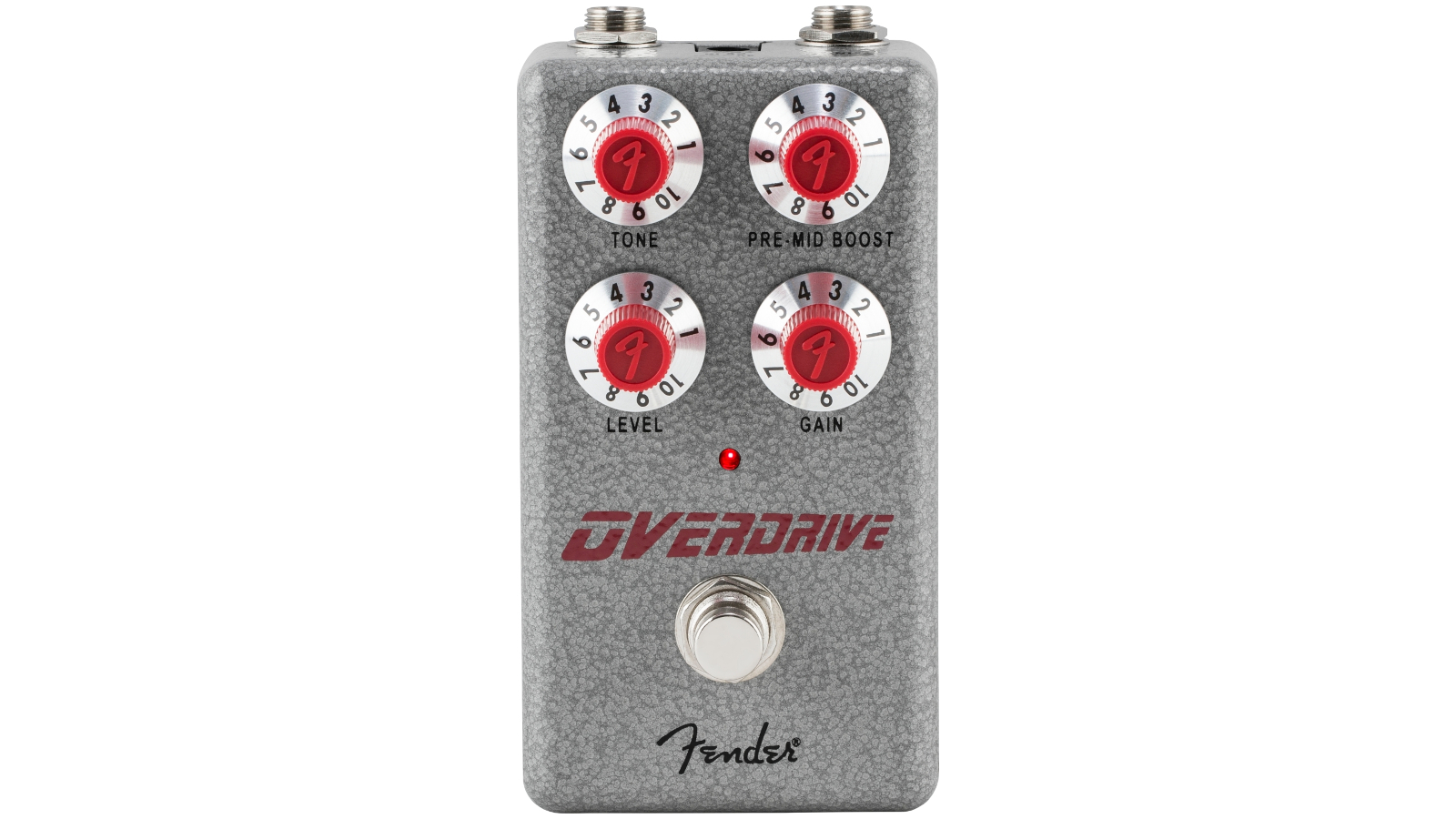
The Overdrive has four red-capped knobs for gain, level, tone and pre-mid boost. The latter is more fully described as a pre-gain mid boost, an EQ control that lets you boost or attenuate the midrange to help dial in your cutting power.
All the latest guitar news, interviews, lessons, reviews, deals and more, direct to your inbox!
In addition, the Overdrive contains an internal trim pot to dial down the ultra-high frequencies, helping you tame single-coil pickups or harsh amps.
A thick, gutsy, medium-gain overdrive that pushes toward heavy saturation with the gain control up high
A thick, gutsy, medium-gain overdrive that pushes toward heavy saturation with the gain control up high, the Overdrive doesn’t try to cop the classics as such, but its flavor and feel lean more toward the earlier days of this breed of pedal – a little Distortion+, if you will – in its body and attitude, without copying that precise tone.
It’s a great tone thickener for single-coils with the gain down lower, and it’s adept at rock and roll with leads wound up higher, with the very effective pre-mid boost dialing between scooped lead tones and in-your-face midrange punch.
SPECIFICATIONS:
Controls: Gain, level, tone, pre-mid boost, internal high EQ
Switches: On/off foot switch
FOR: Easy to dial in, and vintage-leaning tonally, without cloning any specific classic
AGAINST: None
DISTORTION

Orange knobs and a bouncy, cartoonish font seem to hint at a late-’60s/early-’70s British vibe for Distortion’s aesthetics.
It offers up to 15dB of boost and cut for each frequency band in its two-knob EQ, and there are two internal trim pots – midrange and high-end cut – for further EQ tweaking.
The thick, meaty, warm distortion available here takes me quickly to those glory days of super-cranked guitars
The thick, meaty, warm distortion available here takes me quickly to those glory days of super-cranked guitars, when flannel shirts and ripped jeans ruled the streets and grunge segued into heavy rock on stages across the U.S.
Unlike some early “brick wall” distortion pedals, this one was very dynamic and playable, and it interacted nicely with both my tube amps, slathering on a ton of rock tones for a wide array of playing styles.
SPECIFICATIONS:
Controls: Gain, level, bass, treble, internal midrange and high-cut
Switches: On/off foot switch
FOR: Ballsy and characterful, with a lot of external and internal EQ tweakability
AGAINST: None
METAL

Fender’s new Metal pedal gets the black knob caps, naturally, with essentially the same control functions as the Distortion, above, while the internal midrange and high-cut trim pots provide further frequency sculpting.
Does a great job of nailing contemporary high-gain tones
While obviously a sibling of the Distortion, the Metal pedal does a great job of nailing contemporary high-gain tones with a lot of saturation, sustain and razor-sharp sizzle.
Most impressively, it’s all available through a wide range of voices, thanks to the powerful and versatile EQ, which takes you from scooped to gut-punch to machine-grind midrange glory.
Powerful stuff.
SPECIFICATIONS:
Controls: Gain, level, low, high, internal high EQ, internal midrange and high-cut
Switches: On/off foot switch
FOR: Usable and versatile high-gain tones well suited to both contemporary metal and more classic varieties
AGAINST: None
FUZZ
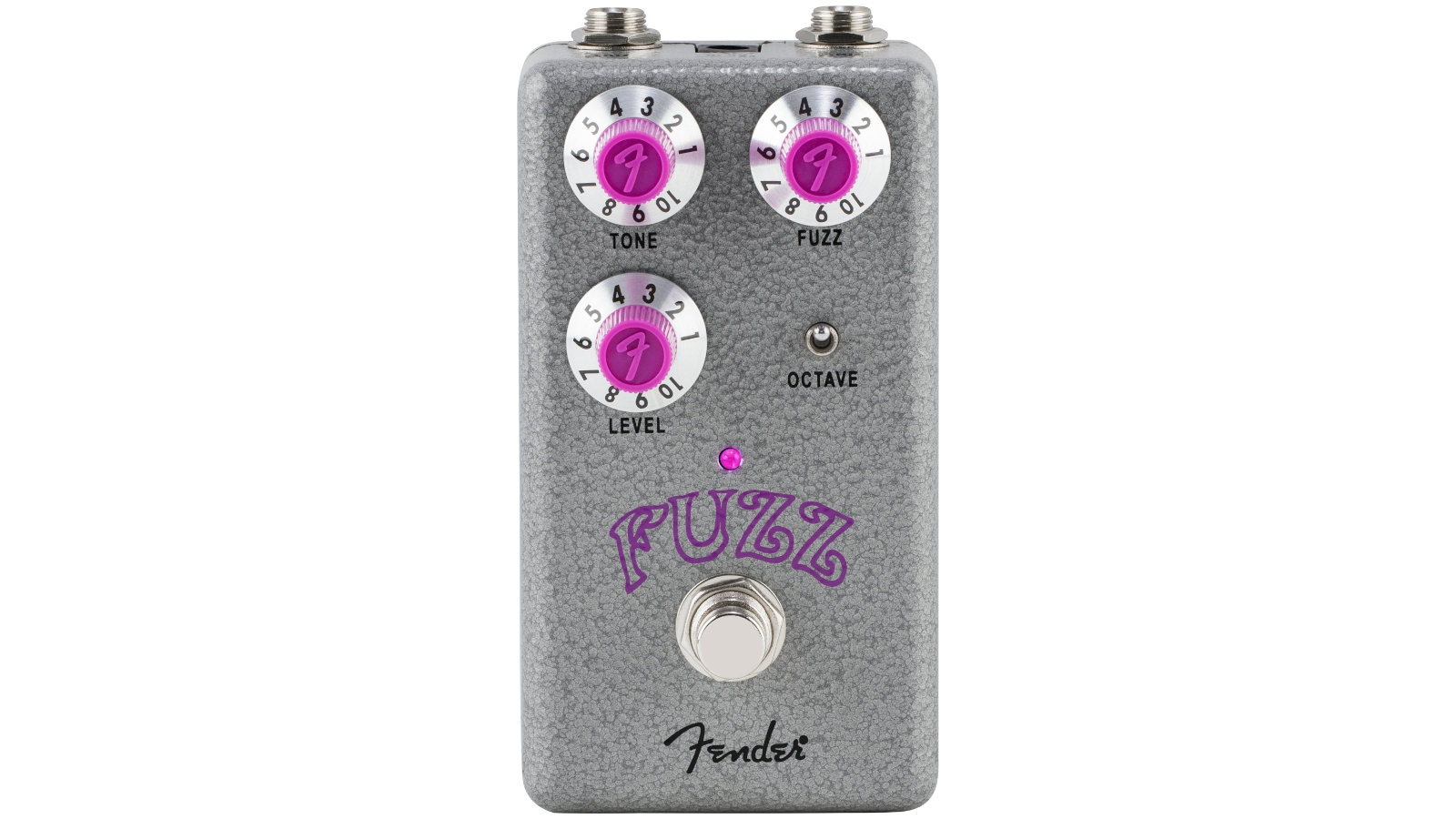
Fender bills the Fuzz as a ’60s-inspired fuzz using silicon diodes, which delivers the lower noise floor and higher output levels demanded by many players circa 2022, while it achieves tones reaching back through several decades.
Pink knobs and a pink LED lead the stylistic cues, and there’s one mini-toggle switch on top to enable the octave-up tone.
Less a smooth-and-treacley lead machine and more a semi-jagged, ripped-Velcro grinder
AGAINST: None
Like the Overdrive, the Fuzz also carries an internal trim pot to further tame super-high frequencies.
While many simple fuzz designs can be one-trick ponies, the Fuzz manages a plethora of moods across the range of its eponymous control.
Less a smooth-and-treacley lead machine and more a semi-jagged, ripped-Velcro grinder, it nevertheless rolls from relatively subtle to gutsy sludge, with plenty of gain make-up to push the amp hard and useful high-end taper from the dual tone and internal EQ controls.
SPECIFICATIONS:
Controls: Fuzz, tone, level, internal high EQ
Switches: On/off foot switch
FOR: Great character and surprising versatility from an edgy and snarly leaning fuzz
DELAY
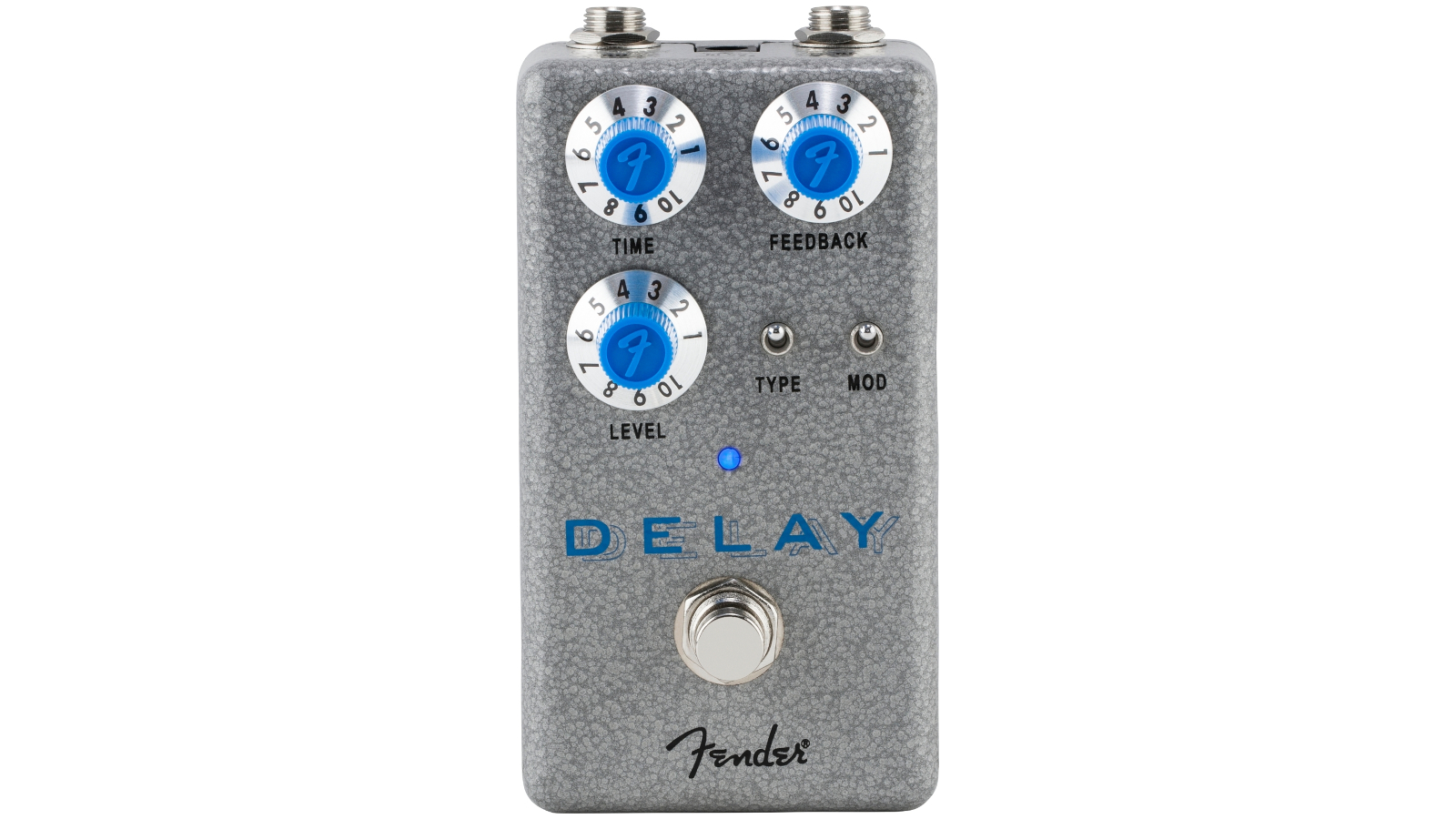
With two different echo pedals among the offerings, the Delay is the more modern all-purpose variety of the pair.
It offers an impressive 950ms of delay time, available in three modes via the external mini-toggle: Digital (a.k.a. modern), Analog and Tape, the latter two obviously emulations thereof.
Proves a great all-purpose contemporary delay pedal
Time, feedback and level controls take the brunt of the duties, and there’s another two-way toggle to add a chorus-like modulation as desired, with rate and depth adjusted at the internal trim pots.
In use, this proves a great all-purpose contemporary delay pedal, with three useful voices running from crisp to characterful, and surprisingly sweet modulation to boot.
I was impressed by both the lack of noise and the quality of the repeats. The feedback knob’s taper is very sensitive, and it’s difficult to go from a single repeat to just two or three without tipping into a dozen or so, but it all functions well otherwise.
SPECIFICATIONS:
Controls: Time, feedback, level
Switches: On/off foot switch, toggles for type and mod(ulation)
FOR: A good-sounding and surprisingly versatile digital delay all round, especially at this price
AGAINST: Early taper on the feedback knob makes it tricky to dial in limited repeats
SPACE DELAY

The Space Delay is more purely dedicated to tape-echo emulations, again via DSP, with a maximum delay time of 950ms.
Its controls are the same as on the Delay pedal – time, feedback and level – but this unit includes a three-way toggle that offers three delay patterns that replicate the repeats from different combinations of tape heads.
An impressive amount of personality overall
It also has an on-off toggle for modulation, with trim pots available inside for rate and depth.
Although it otherwise seems similar to the Delay, the Space Delay’s dedication to tape-emulated character throughout all of its settings means there’s more analog-emulated personality throughout the range, which is something I might prefer if I were using this for retro-voiced stylings or even more trenchant shoe-gazing atmospherics.
As such, it’s relatively warm and thick throughout, and the three repeat pattern selections provide easy access to creative feedback variations.
Its modulation is similar to that of the Delay, too, giving it an impressive amount of personality overall.
SPECIFICATIONS:
Controls: Level, feedback, time
Switches: On/off foot switch, toggles for pattern and mod(ulation)
FOR: A lot of tape-emulated character and handy features in an easy and affordable package
AGAINST: Can take some fine tuning to balance your ideal pattern switch and feedback knob settings
REVERB

I can see the Reverb pedal at this size and price point appealing to a lot of players who need a little splash or ambience in their rig but don’t want to mess with the prices or complex interfaces of some of the bigger digital engines out there.
Controls include level, tone and damp, the latter gradually attenuating highs and eventually squelching the reverb tails when used in extreme.
Although Fender’s literature declares “Fender & Reverb – name a more iconic duo,” the three-way mode switch accesses Hall, Room and Plate reverbs, with no emulation of the spring reverb that the company proliferated in the ’60s.
Appealing to a lot of players who need a little splash or ambience in their rig
The tone switch instantly shelves highs in the reverb signal to warm it up.
As a useful pedal for dialing in a little room sound or more dramatic effects, the Reverb doesn’t really suffer much from the lack of a spring setting, since many players today are looking for atmospherics more than that surfy splash.
At lower time and level settings, the differences between types are subtle, but turning them up about halfway reveals lush, dark reverberations in the Hall setting in particular, as well as some very useful Plate sounds, although higher level settings start to sound a little gimmicky.
SPECIFICATIONS:
Controls: Time, level, damp
Switches: On/off foot switch, toggles for type and tone
FOR: Handy, good sounding and priced right for those who need a little or a lot of room sound in a compact package
AGAINST: No spring emulation, but arguably it doesn’t need it
CHORUS
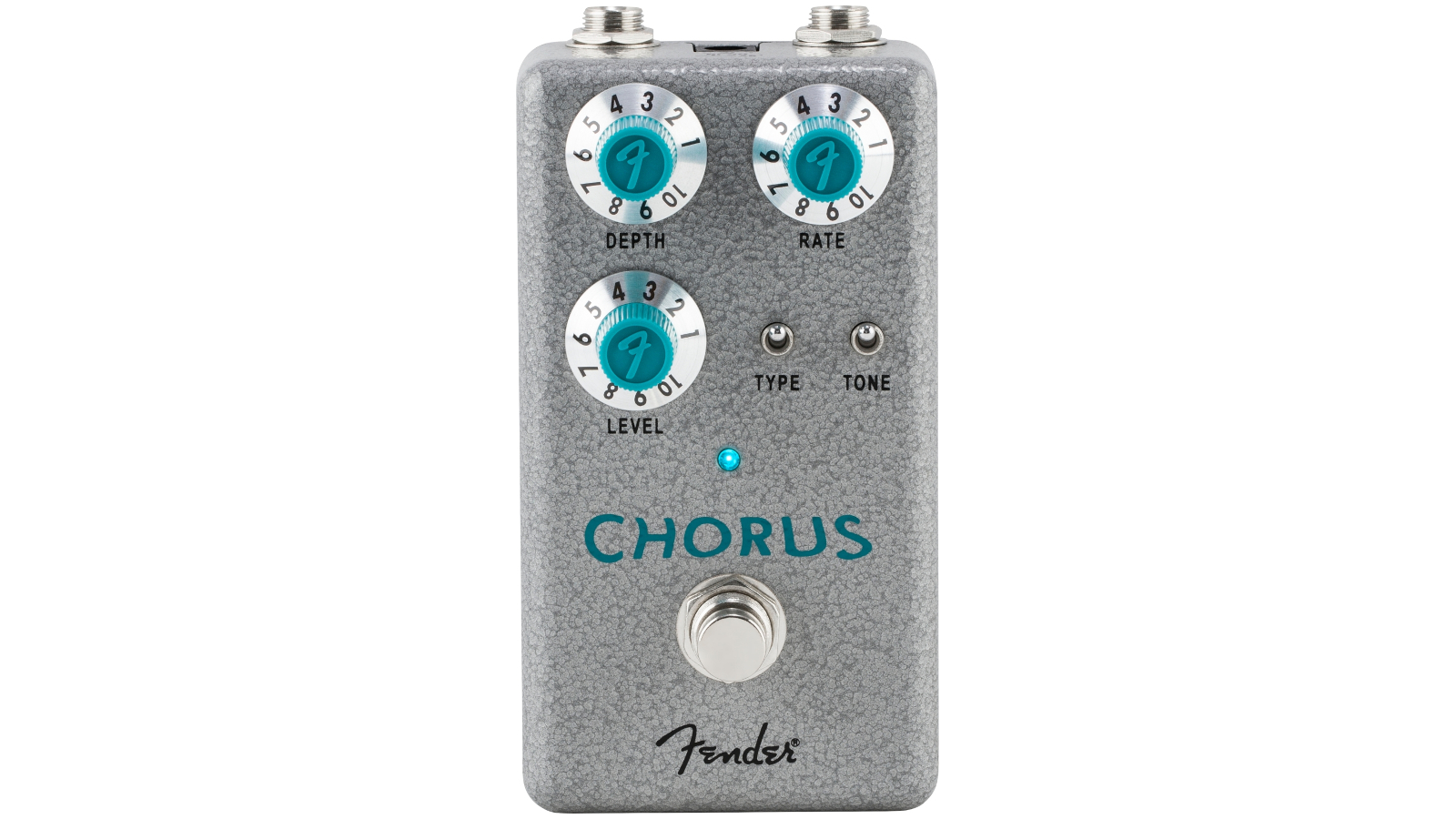
The surf-green knobs for rate, depth and level control are the most significant parameters on the Chorus, while the type toggle taps three classic chorus styles, and the tone toggle tames the highs in the wet signal to help it sit less obtrusively in the mix.
Although it leans toward more contemporary sounds, the Chorus pedal’s type switch provides a decent variety of voicings, allowing it to dial up an impressively usable palette of shimmer and swirl for a broad range of genres.
A handy sub-$100 box
Subtler settings proved to be my favorites, adding luscious depth and motion without getting too seasick.
It’s a very good-sounding pedal overall, with maybe a little background noise when the level is turned up.
For those who don’t require more complex or vintage-precise choruses, this is a handy sub-$100 box.
SPECIFICATIONS:
Controls: Rate, depth, level
Switches: On/off foot switch, toggles for type and tone
FOR: A good sounding chorus with impressive flexibility for its size and price range
AGAINST: Arguably sounds a little metallic at deeper depth and level settings
FLANGER

A digital modulation circuit with analog dry-through signal powers the Flanger, which offers impressive versatility despite its outward simplicity.
Seafoam-green-capped knobs offer control over rate, depth and manual (the latter sweeps through the resonance range).
The three-way res toggle offers different intensities of resonance, while the type switch toggles between more intense and mellower flanging sounds.
A sweet little flanger with a surprisingly tasty core voicing
There’s no internal trim pot.
Flanging is another ’70s child that really saw its heyday in the 1980s, and the Flanger impressed me by being more usable and musical than many, which is saying something at this price range.
Just a touch adds lovely dimension and spin to the tone without the nausea-inducing space-time-melding sounds that some issue forth, though it will do those too if you push it hard.
Overall, this is a sweet little flanger with a surprisingly tasty core voicing.
SPECIFICATIONS:
Controls: Depth, rate, manual
Switches: On/off foot switch, toggles for res(onance) and type
FOR: Impressively natural and organic sounding for a lower-priced flanger
AGAINST: None
Visit Fender for more information.
Dave Hunter is a writer and consulting editor for Guitar Player magazine. His prolific output as author includes Fender 75 Years, The Guitar Amp Handbook, The British Amp Invasion, Ultimate Star Guitars, Guitar Effects Pedals, The Guitar Pickup Handbook, The Fender Telecaster and several other titles. Hunter is a former editor of The Guitar Magazine (UK), and a contributor to Vintage Guitar, Premier Guitar, The Connoisseur and other publications. A contributing essayist to the United States Library of Congress National Recording Preservation Board’s Permanent Archive, he lives in Kittery, ME, with his wife and their two children and fronts the bands A Different Engine and The Stereo Field.
